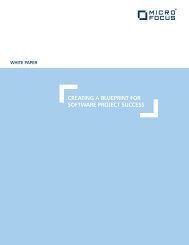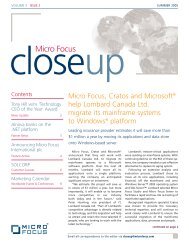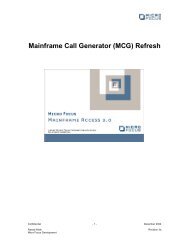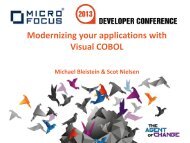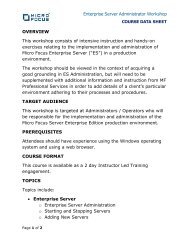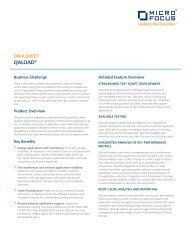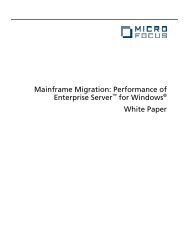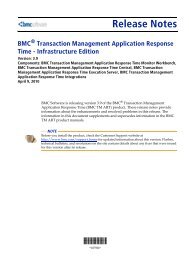On UNIX platforms, before the introduction of Server ... - Micro Focus
On UNIX platforms, before the introduction of Server ... - Micro Focus
On UNIX platforms, before the introduction of Server ... - Micro Focus
You also want an ePaper? Increase the reach of your titles
YUMPU automatically turns print PDFs into web optimized ePapers that Google loves.
The case for using CSO in place <strong>of</strong> .gnt modules<br />
<strong>On</strong> <strong>UNIX</strong> <strong>platforms</strong>, <strong>before</strong> <strong>the</strong> <strong>introduction</strong> <strong>of</strong> <strong>Server</strong> Express, customers would typically develop<br />
and debug <strong>the</strong>ir code using .int (intermediate code), because it could be Animated and it was<br />
portable> Customers would <strong>the</strong>n compile <strong>the</strong>ir applications to .gnt (generated native code) or<br />
executable format when <strong>the</strong>ir code was ready to run in production. The advantage <strong>of</strong> executable<br />
and .gnt was that <strong>the</strong>se formats run substantially faster than .int.<br />
<strong>Micro</strong> <strong>Focus</strong> COBOL has been available on <strong>UNIX</strong> for more than a decade, and a large customer base<br />
has grown accustomed to <strong>the</strong> approach <strong>of</strong> debugging with .int and running with .gnt or executable<br />
modules. Mission-critical applications have been successfully running .gnt for years, and customers<br />
have grown to trust this arrangement.<br />
<strong>Server</strong> Express <strong>of</strong>fers a new object module format called <strong>the</strong> Callable Shared Object (CSO). This<br />
format can be used as an alternative to .gnt. CSOs are created with <strong>the</strong> "-z" flag <strong>of</strong> <strong>the</strong> "cob"<br />
command, and <strong>the</strong>y take <strong>the</strong> file name extension ".so". CSOs are similar to .gnts in that <strong>the</strong>y are<br />
dynamically loadable, are native code in format, and run just as fast (or faster). They can do<br />
everything that .gnts can do, and <strong>the</strong>y <strong>of</strong>fer o<strong>the</strong>r advantages. They run as "shared text", and <strong>the</strong>y<br />
allow several subprograms to be combined and loaded at once, possibly including subprograms from<br />
o<strong>the</strong>r languages such as C or C++.<br />
Shared Text<br />
Generated code files (.gnt) cannot be shared between processe. So, if two <strong>UNIX</strong> processes call a<br />
subprogram compiled to .gnt, a separate copy <strong>of</strong> that subprogram is loaded into each process's<br />
virtual memory space. The <strong>Micro</strong> <strong>Focus</strong> dynamic loader reads .gnt files into <strong>the</strong> .data section, and<br />
each <strong>UNIX</strong> process keeps its own private copy <strong>of</strong> <strong>the</strong> .data section.<br />
CSOs are in an operating system format and can be shared between processes. If two <strong>UNIX</strong><br />
processes call a subprogram created as a callable shared object at <strong>the</strong> same time, that program is<br />
loaded only once. The operating system shares <strong>the</strong> procedural code and creates separate data areas<br />
for each process. Depending on <strong>the</strong> architecture <strong>of</strong> <strong>the</strong> application and <strong>the</strong> number <strong>of</strong> simultaneous<br />
users, this can be a substantial advantage.<br />
Straightforward Conversion<br />
Although <strong>Server</strong> Express and its Callable Shared Objects have been available for four years,<br />
SupportLine still notices many customers using <strong>the</strong> .gnt format in production. The .gnts have<br />
performed well, and customers imagine that a conversion to CSOs will involve extra effort in<br />
engineering and QA. They think, "if it's not broken, don't fix it".<br />
But <strong>the</strong>re is a straightforward way to realize at least <strong>the</strong> "shared text" advantage <strong>of</strong> CSOs. In <strong>the</strong><br />
customer's Makefiles or build scripts, where <strong>the</strong> "-u" flag <strong>of</strong> <strong>the</strong> "cob" command appears, this can be<br />
replaced with <strong>the</strong> "-z" flag, <strong>the</strong>n a ".so" file will be created in place <strong>of</strong> each .gnt. Replacing .gnt files<br />
with CSOs on a one-to-one basis is a conceptually simple change (even within complex<br />
applications). It is not likely to introduce any problems and can be tested in one QA cycle.<br />
Customers should be encouraged to try this approach.<br />
It is important to realize that, at execution time, <strong>the</strong> operating system will look for CSOs on <strong>the</strong><br />
"library path" environment variable, that is, LIBPATH on AIX, SHLIB_PATH on HP, or<br />
LD_LIBRARY_PATH on o<strong>the</strong>r <strong>UNIX</strong> versions. The library path must include <strong>the</strong> location <strong>of</strong> <strong>the</strong> CSOs,<br />
even if this location happens to be <strong>the</strong> current working directory.<br />
Combining subprograms for performance, and including C and C++<br />
When .gnt modules are used, for each COBOL source file (.cbl) a separate .gnt file would be<br />
created. Then, <strong>the</strong> dynamic loader would have to find and load each .gnt individually at run time.<br />
However, if you choose to do so, several COBOL programs can be combined into a single CSO. This<br />
has <strong>the</strong> advantage that references between <strong>the</strong> programs can be resolved without <strong>the</strong> dynamic<br />
loader having to search for and load ano<strong>the</strong>r module. For example:<br />
Page 1 <strong>of</strong> 2
The case for using CSO in place <strong>of</strong> .gnt modules<br />
cob -z myprog.cbl subprog.cbl entry.cbl<br />
compiles <strong>the</strong> three COBOL programs and links <strong>the</strong>m toge<strong>the</strong>r, creating myprog.so. The entry point<br />
<strong>of</strong> <strong>the</strong> CSO is myprog (<strong>the</strong> first COBOL program listed on <strong>the</strong> line).<br />
The cob -z option accepts .int files and system object (.o) files as input, as well as C and C++<br />
source or object code. For example:<br />
cob -zo myapp.so mycobol.cbl myint.int myc.c myobj.o -e myentry<br />
creates myapp.so using <strong>the</strong> COBOL programs mycobol.cbl and myint.int, <strong>the</strong> C source code myc.c,<br />
and an object file myobj.o, which could be COBOL, C, C++ or some o<strong>the</strong>r language. The main entry<br />
point is "myentry" which could be an entry point in any <strong>of</strong> <strong>the</strong> specified modules.<br />
A CSO does not need to contain COBOL, so "cob -z" can be used to create CSOs containing only C<br />
or C++ or o<strong>the</strong>r objects. Prior to <strong>Server</strong> Express, C and C++ needed to be linked into a system<br />
executable or a new runtime system. This is no longer necessary, as <strong>the</strong>y can now be linked into<br />
callable shared objects, and be brought in dynamically at run time. This allows much greater<br />
flexibility when creating mixed-language applications.<br />
For more information about CSOs and <strong>the</strong>ir advantages over <strong>the</strong> more traditional .gnt format, I<br />
recommend <strong>the</strong>se areas <strong>of</strong> <strong>the</strong> <strong>Server</strong> Express documentation:<br />
User's Guide Chapter 3: Packaging Applications<br />
Chapter 8: Callable Shared Objects<br />
Chapter 9: Linking to System Executables<br />
and Chapter 10: COBOL System Interface (Cob)<br />
The <strong>Server</strong> Express documentation (along with documentation for o<strong>the</strong>r <strong>Micro</strong> <strong>Focus</strong> products) is<br />
available on <strong>the</strong> Documentation CD that comes with <strong>the</strong> product and is also accessible from <strong>the</strong><br />
<strong>Micro</strong> <strong>Focus</strong> web page www.micr<strong>of</strong>ocus.com. Start by selecting <strong>the</strong> "Support" link at <strong>the</strong> top <strong>of</strong> <strong>the</strong><br />
home page. Then select <strong>the</strong> "Documentation" link in <strong>the</strong> "Self-Service" menu.<br />
Page 2 <strong>of</strong> 2




